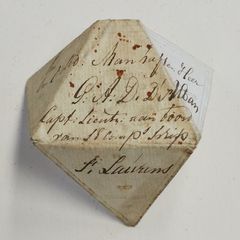A matter of kinks
A matter of kinks
A matter of kinks
Vows of love, business secrets, news from a distant homeland: how could confidential lines be sent centuries ago - before the emergence of sealable envelopes? It is a question of folding and the appropriate sealing mechanisms, as historian Lucas Haasis elaborates in this guest contribution.
During the early modern period, there were no envelopes for letters – standardised envelopes became common only later. Instead, for centuries people used the letter paper itself to produce folded letters and letter packets ready to be sent. The folded letter paper served as envelope at the same time. Correspondence was sealed by means of specially developed letterfolding and letterlocking techniques.
In order to produce a ready-to-send letter or a letter packet from the letter paper itself, several manipulations were necessary: Letter paper was folded in different ways, pushed into each other and interlocked to fix the letter packet. Different composites and adhesives were used (such as sealing wax or wafer). The senders deliberately inserted slits and holes in the paper in order to use specially designed material letterlocks or to pull different materials through them. Such letterlocks were made of paper cuttings, cut off from the letter paper itself or obtained separately, but also of silk thread, cords and other materials, usually additionally bound with sealing wax.
The project letterlocking.org has been pioneering the research of these techniques of letter folding and letterlocking for more than ten years. Recently, the project team presented its own catalogue of common folding and letterlocking techniques. Together with experts from Kings College London and the Massachusetts Institute of Technology, the team was also able to scan and virtually unfold a letter that still remained sealed. This letter belongs to the Brienne Collection - a postmaster's trunk that, like the Prize Papers, has been preserved in its original state.
The Prize Papers project team in London, Oldenburg and Göttingen, with its combined expertise in the conservation and presentation of material properties of letters as well as in sorting and research, has been cooperating with the letterlocking team around Jana Dambrogio and Daniel Starza Smith for years. This collaboration resulted, for example, in a large workshop on the topic of materiality in 2019. The data model of the Prize Papers project allows for the inclusion of material properties of letters such as folding and letterlocking techniques, so that these will also become searchable in the Prize Papers portal in the future.
The Prize Papers are invaluable for research into the material properties of letters and correspondence, as many of the estimated 160,000 letters have survived in their original condition to this day. Many letters are still folded, some even still sealed, which allows the folds to be reconstructed and researched today. Our research is done in close coordination between the project partners.
With this approach, our distinct materiality approach, the Prize Papers project places a special focus and emphasis on the preservation, documentation and presentation of the original condition of the documents and artefacts in the Prize Papers collection. We document letter folding and locking techniques in materiality shots and videos. This documentation allows us to create models of typical and less typical early modern epistolary techniques that are represented in the collection.
What is special about the Prize Papers is that different preferences for material practices emerge – depending on the social status, gender, age and geographical origin or place of residence of the writers. The collection offers a unique opportunity to explore the material world of past letter communication.


